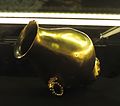Treasure of Mala Pereshchepyna
The treasure of Mala Pereschtschepyna is a deposit found on June 11, 1912 on the banks of the Vorskla near Mala Pereschtschepyna in the Poltava Governorate of the Russian Empire . It is dated to the 7th century and is attributed to Khan Kubrat (also Kobrat, from qobrat - "gather the people"), the founder of the Greater Bulgarian Empire .
history
Find and 1st World War
On May 29th, Jul. / June 11, 1912 greg. two boys found a metal goblet while herding cows. They took him home and showed him to the father of one. He thought that the precious chalice had been stolen from the nearby church and took it to the priest. Since he did not know the chalice, the story of the boys was believed and the authorities were notified. The police and experts from the Archaeological Commission did not arrive at the site until two days later. Some of the finds were looted and were recovered when the police searched the area. Over 800 individual pieces were found, mainly made of silver (approx. 50 kg) and gold (approx. 20 kg). In 1913 Nikolay Makarenko announced a detailed description of the find and in 1914 Count Alexei Alexandrovich Bobrinsky ( Алексей Александрович Бобринский ) presented the find in detail at a London congress.
Due to the beginning of the First World War , the find was forgotten and was stored in the Hermitage .
Between the wars and World War II
During further investigations, the complex was finally made accessible in 1928. It consists of the depot and two nearby grave remains. When it was first found, there were several personal grave goods, and this is why the treasure is also known as a grave find today. These grave goods include u. a. a couple of stirrups, parts of a quiver, or a golden spoon.
The find remained in Leningrad during the Second World War .
Post-war until today
At the beginning of perestroika , the German scientists Joachim Werner and Werner Seibt were able to research the find for the first time.
On May 24, 2019, Kubrat's sword from the find was exhibited in the Prince's Palace in Sofia . The artifact was presented to the public in the presence of the Bulgarian Prime Minister Boyko Borisov , the Deputy Director of the Hermitage (Saint Petersburg) and the General Director of UNESCO Audrey Azoulay . The export of the sword from Russia was only possible with the express permission of President Vladimir Putin .
literature
- Бобринской А. А. Перещепинский клад. Материалы по Археологии России No 34, Петроград 1914, С. 111–120 и табл. (Bobrinskoj, AA Pereščepinskij klad. Materialy po Archeоlogii Rossii No 34 [ The Treasure of Pereščepina, Materials on Archeology of Russia No. 34 ]), Petrograd 1914, pp. 111–120 and illustrations. http://kronk.spb.ru/library/bobrinskoy-aa-1914.htm
- Joachim Werner: The grave find of Malaja Pereščepina and Kuvrat, Kagan of the Bulgarians. Publishing house of the Bavarian Academy of Sciences, Munich 1984.
- Залесская В. Н. и др. Сокровища хана Кубрата . Санкт Петербург 1997 (Zalesskaja, VN et al: Sokrovišča chana Kubrata [ The Treasures of Khan Kubrat ]. Saint Petersburg 1997).
- Сокровища хана Кубрата: Альбом . Санкт Петербург 1997 ( Sokrovišča chana Kubrata: Albom [ The Treasures of Khan Kubrat: illustrated book ]. Saint Petersburg 1997).
- Гавритухин И. О. Хронология эпохи становления Хазарского каганата . Хазары . Москва, 2005. (Gavrituchin, IO: Chronologija ėpochi stanovlenija Chazarskogo kaganata . Chazary . [ The chronology of the era of the emergence of the Khazar Khanate . The Khazars ] Moscow 2005).
- Комар А. В . Перещепинский комплекс в контексте основных проблем истории и культуры кочевников Вочевников Вочевников Вовычноа Евроч Евроч VII - VIII. Степи Европы в эпоху средневековья . Донецк, 2006. Т. 5. (Komar, AV: Pereščepinskij kompleks v kontekste osnovnych problem istorii i kul'tury kočevnikov Vostočnoj Evropy VII - načala VIII v. Stepi Evropy w ėpochu srednevekov'ja [ The complex of Pereščepina in the context of fundamental problems of the history and culture of nomads in Eastern Europe from the 7th to the beginning of the 8th century. The steppes of Europe in the Middle Ages ] Vol. 5 , Doneck 2006).
Web links
- Entry on the treasure of Mala Pereshchepyna in the Encyclopedia of the History of Ukraine (Ukrainian)
- Keyword "Treasure of Pereščepina" in the Great Russian Encyclopedia (Russian)
- List of finds in the Hermitage collection
Individual evidence
- ↑ Inventory number W-1052 of the Hermitage Description on the museum page. Retrieved April 23, 2020.
- ↑ Малоперещепинський скарб Entry on the treasure of Mala Pereshchepyna in the Encyclopedia of Modern Ukraine ; accessed on April 22, 2020 (Ukrainian)
- ↑ Iranica Protobulgarica description on krorania.com. Accessed April 23, 2020 (pdf)
- ↑ Перещепинското съкровище, съкровището на Княз Кубрат Veselin Trakiyski on academia.edu. Retrieved April 23, 2020 (pdf) (Bulgarian)
- ↑ Одну из самых богатых находок ХХ века Report on fakty.ua. Retrieved April 23, 2020 (Russian)
- ↑ Inventory number 1930-132 of the Hermitage Description on the museum page . Retrieved April 23, 2020.
- ↑ Inventory number 1930-115 of the Hermitage Description on the museum page . Retrieved April 23, 2020.
- ↑ Inventory number 1930-7 of the Hermitage Description on the museum page . Retrieved April 23, 2020.
- ↑ The grave find of Malaja Pereščepina and Kuvrat, Kagan of the Bulgarians
- ↑ Ще говорим с Ермитажа за отливки на меча и пръстена на хан Кубрат Article from May 24, 2019 on monitor.bg. Retrieved April 23, 2020 (Bulgarian)
- ↑ Мечът и пръстенът на хан Кубрат пристигнаха у нас news section on nova.bg. Retrieved April 23, 2020 (Bulgarian)





